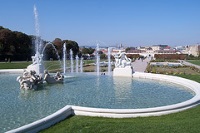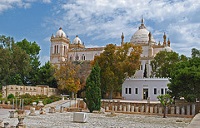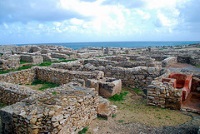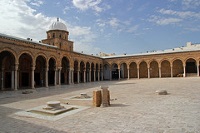
Tunis' largest parks, Belvedere Park covers 270 acres (110 ha) just north of the city. Known as the 'Lungs of Tunis' due to the scarcity of green spaces in the city, Belvedere Park has a number of family-friendly attractions to enjoy on fine days in Tunis. Children will love the Tunis Zoo, a pleasant facility with monkeys, bears, deer, peacocks, and elephants; while adults will marvel at the intricately-decorated high domed ceilings of the Turkish Pavilion. Belvedere Park has an art gallery featuring local contemporary works near the entrance gate, and when the weather is hot visitors can cool off in the shade of trees overlooking Lake Tunis on Place Pasteur.

Carthage was the base of a powerful trading empire during the Phoenician and Punic periods, ruled by the infamous conqueror Hannibal. Destroyed by the Romans in the 2nd century BC, the site was redeveloped a century later and became a Roman capital. Located in an affluent suburb roughly nine miles (15km) north of Tunis, the remaining ruins of ancient Carthage were declared a UNESCO World Heritage Site in 1991. Visitors can buy a ticket for just a few dinars that allows access to up to 10 different archaeological sites, including the Antonin Baths, Amphitheatre, Water Cisterns, Basilica of Saint-Cyprien, Punic Tophet, and the Carthage Museum. Also on-site in the museum complex is the Acropolium (St Louis Cathedral), a stunning cathedral built in the late 19th century.
Address : Nine miles (15km) north of central Tunis

Approximately 50 miles (80km) east of Tunis lies Kerkouane, a former city of the Phoenician and Punic periods. The city was abandoned around the 3rd century BC, which meant it was largely ignored by the conquering Romans and is today the only remaining untouched Punic settlement. The city was declared a UNESCO World Heritage Site in the 1980s. The remains of Kerkouane and its famous necropolis are not large, and can be explored in about an hour. Visitors can look for the distinctive minimalist mosaics of the Punic god Tanit, and learn about the city's surprisingly modern town-planning. A small museum housing interesting relics and artefacts gives further insight into the history of Kerkouane. Set along an attractive bit of Tunisian coastline, visitors from Tunis will enjoy the peace of the site and lovely ocean views. The museum shop sells a few souvenirs and snacks, but a picnic lunch is the best complement to an excursion to Kerkouane.

The largest mosque in Tunisia, the Zitouna Mosque dates back to the 8th century; the 160 columns of the mosque were brought from the ruins of Carthage. Set in the heart of Tunis, the mosque was improved upon almost continually until the 19th century, when the minaret was added. Zitouna (or Al-Zaytuna) was the centre of learning and intellectual pursuits in Tunisia, and is considered the first Islamic university. Visitors to the Zitouna Mosque must dress modestly, and non-Muslim guests may only enter the courtyard. The mosque is surrounded by bustling souks on three sides.

Travel Guide powered by Word Travels, copyright © 2023 Globe Media Ltd. By its very nature information in this travel guide is subject to change at short notice and travellers are urged to verify information on which they're relying with the relevant authorities. Neither Globe Media Ltd nor Travel Vogue can accept any responsibility for any loss or inconvenience to any person as a result of information contained above.